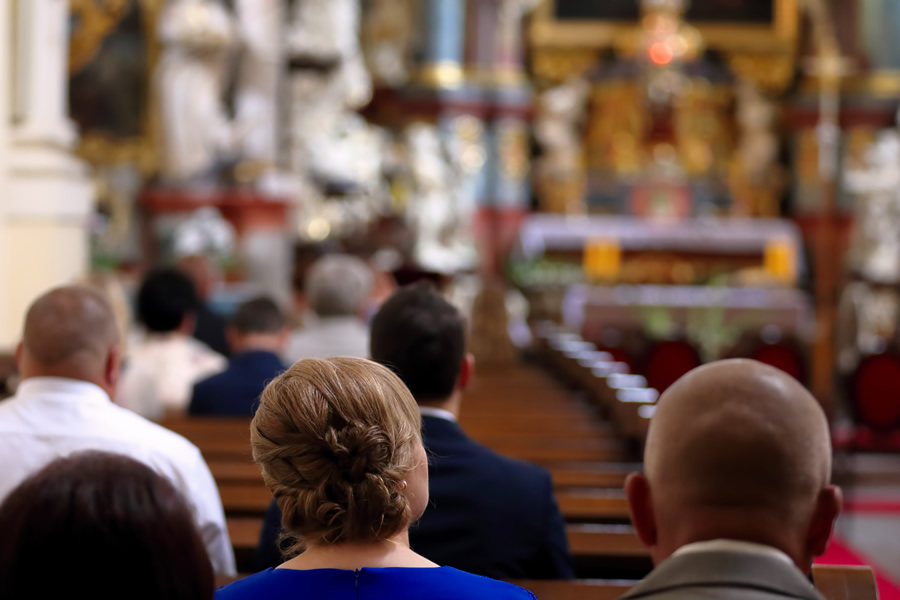
God’s Pilgrim People: Liturgical Processions
by Kathy Kuczka © LTP | 06/02/2024 | A Message from Our PastorPeople across the United States are preparing to celebrate Independence Day with block parties, fireworks, and parades! Many cities host elaborate parades featuring floats, marching bands, and costumed characters to commemorate the nation’s birth.
Catholics, too, appreciate the community-building power of parades. At Mass, processions reveal our identity as a pilgrim people following in Christ’s footsteps. Processions also mark life transitions, special times in the liturgical calendar, and lead us to step out into the world with the Good News of God’s love.
At Mass
The entrance procession. The entrance procession unites members of the assembly, focusing their attention on the celebration before them. This procession begins with the cross—the central mystery of our faith and symbol of the self-giving love of Christ. The Book of the Gospels is also carried in the entrance procession, reminding us that it is Christ who speaks when the Gospel is proclaimed.
Dismissals. Dismissals are also processions. In many parishes children are dismissed from the church to celebrate the Liturgy of the Word in a separate space. They walk behind a leader who holds a lectionary as a sign that they are learning to incorporate the God’s Word into their lives. Likewise, catechumens are dismissed following the homily. As they leave the sanctuary, they too are led by a person carrying a lectionary or the Book of the Gospels, signifying that the Scriptures are the foundation of their faith journey.
Gospel procession. The deacon or priest carries the Book
of the Gospels to the ambo before the Gospel is proclaimed, underscoring our deep respect for Christ, the living Word of God.
The offertory procession. Members of the assembly bring bread and wine to the altar. In the early Church, persons would also bring gifts for widows, orphans, and those in need as an expression of their desire to imitate Christ’s self-giving love. The procession toward the altar reminds the assembly that they are to offer themselves with Christ.
The Communion procession. The procession to the Lord’s table signifies the unity and communion of the faithful with Christ and with one another.
The concluding rites. Worshippers are sent forth with words such as “Go and announce the Gospel of the Lord.” This final procession may be the most important of all, as members of the assembly leave together but then scatter to bring the Good News to all those they encounter.
In Various Times and Seasons
Liturgical processions mark transitions in the seasons of our lives. Processions at the beginning and end of the Order of Matrimony demonstrate a change from the single state of life to the sacramental union of married life. Processions with a coffin or cremated remains during a funeral represent the transition from death to eternal life.
Processions also help the faithful observe different times and feasts of the liturgical year. Holy Week begins with the procession of palms on Palm Sunday, commemorating the Lord’s final entrance into Jerusalem. At the conclusion of the liturgy on Holy Thursday, the ministers and the people process from the church, carrying the Blessed Sacrament toa place where it will be reserved for the sick and homebound and for the liturgy on Good Friday. On Good Friday, the faithful process to venerate the cross as they unite themselves with the suffering of Christ. On Holy Saturday, the people process into the church, following the paschal candle, symbol of the risen Lord and the light of the world. On the Solemnity of the Most Holy Body and Blood of Christ, many parishes and dioceses host a Eucharistic procession with the Blessed Sacrament.
All liturgical processions remind us that the faithful are pilgrims united with Christ and with one another as we live out our journey of faith.
Text by Kathy Kuczka, author of Connecting the Liturgy with Our Lives: Print and Digital Resources for Faith Formation (LTP, 2019).
www.LTP.org. Pastoral Liturgy® magazine, May/June 2024, www.PastoralLiturgy.org.
BACK TO LIST BACK